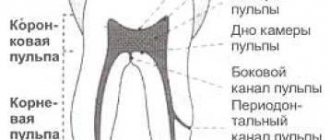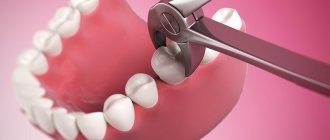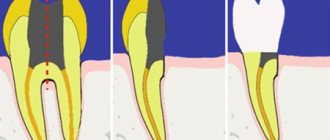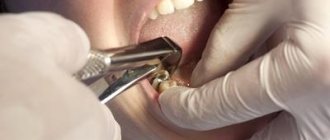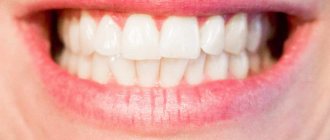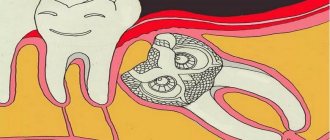When is it necessary to remove a tooth root?
In all cases, the doctor decides individually whether the situation requires tooth root removal after carrying out diagnostic measures and examination using radiography or visiography. Among the most common indications for tooth root removal are the following:
- the patient suffers from aching and throbbing pain in the tooth;
- in the peri-root area there is some swelling of the gums;
- there are signs of inflammation;
- the root of the tooth is destroyed;
- third degree of tooth root mobility;
- tooth fracture is of increased complexity;
- the level at which the destruction of the dental crown is located is located below the level of the gums;
- a cyst was diagnosed.
If the rotting tooth root is not removed in a timely manner, it can give rise to a serious infectious process in the oral cavity, as well as bad breath. Problems will certainly affect healthy tissues nearby.
In some cases, even in the presence of inflammation and severe tooth decay, you can do without root removal. This will allow, after carrying out the necessary therapeutic measures, to restore or build up the tooth. The final decision on this issue is made by the dentist.
Caries on a wisdom tooth: treat or remove
Many people have known since childhood that “wisdom” molars are an atavistic heritage. Then the information is laid down that these are molars that are unnecessary for a person, and they need to be removed immediately after eruption. Competent dentists today do not support this opinion.
The situation needs to be viewed from two perspectives.
- Should wisdom teeth be removed if they don’t bother me? Definitely no. Especially if the molars are paired - there is both an upper and a lower one, and also in the absence of mobility, caries and even growth in the dentition.
- Hole in wisdom tooth – treat or remove? It's a little more complicated, but there are more reasons to preserve the third molar than to extract it.
No dentist will answer the question “wisdom tooth caries – treat or remove” without examining the patient. The decision to save a molar is accompanied by an objective assessment of many factors. The doctor looks:
- The degree of damage is the number of caries lesions, their location, and the presence of other dental problems. It happens that a patient comes with “caries,” but in reality it turns out that the carious process has already gone far. And here several options are possible - pulpitis, periodontitis, cyst, wisdom tooth granuloma.
- Location under or above the gum tissue - retracted and semi-retracted teeth often bother patients, but it is not difficult to solve this problem with modern medicine.
- Quality of growth. Wisdom teeth do not always grow straight. Sometimes it interferes with chewing, injures the soft tissues of the cheek, and serves as a constant source of discomfort.
Studying all aspects of the disease, painstaking and accurate diagnosis will help the doctor make a decision on treatment and select the optimal sequence of manipulations.
New technologies guarding “wisdom”
The decision has been made - we need to treat. Often such information leads the patient to panic, expecting pain and discomfort. Don't worry. Complete painless treatment is guaranteed by modern equipment and the professionalism of the doctor.
When sanitation of the oral cavity, the dentist uses:
- Modern equipment. Installation with a bur rotation speed of 150, 300, 500 rpm with forced water-air cooling of the tip guarantees the absence of unpleasant vibration, eliminates overheating of the tooth, and almost completely eliminates pain. Allows treatment without anesthesia, but for hypersensitive and panicking patients, pain relief remains a necessity.
- High quality anesthesia. There are many options. The choice depends on the skills and knowledge of the doctor and the equipment of the clinic. You can “freeze” half of the patient’s face for 6-8 hours or deprive the patient of discomfort in the local area for 40-60 minutes, which is necessary for the treatment of wisdom tooth caries. Infiltration anesthesia - intraligamentary and intraseptal - for high-quality “freezing” is used in clinics of a high level of service. Monitoring the professionalism of dentists and their frequent training ensure full mastery of complex anesthesiological techniques.
The use of modern treatment methods makes it possible to get rid of even pulpitis of the third molar. The presence of numerous channels, their arbitrary curvature, and deep damage to the structure are not a problem for innovative technologies. Of course, the doctor will need full control of the process - high-quality x-rays, the use of a dental microscope, an apex locator, and other tools and devices.
The result of the efforts is logical: the quality of the work is excellent, and the patient’s “wise” molar is preserved.
Tooth root removal: painful or not?
Most often, the situation in which tooth root removal is indicated occurs when the pulp is dead. To avoid pain and discomfort, the “Optimal Choice” dental clinics use modern high-quality local anesthesia before tooth root removal and other manipulations. Therefore, you should not be afraid of pain and put off visiting the dentist for the indefinite future. Today the procedure takes place with a minimum of discomfort.
Prices for wisdom tooth removal in the upper jaw
Tooth extraction is simple:
- X-ray images
- Anesthesia
- Removal of a tooth
- Applying and removing sutures
- Postoperative examinations
Price : from 3,000 ₽ to 7,800 ₽
Tooth extraction is complicated
| from 10,000 to 20,00 ₽ |
At the Implantmaster clinic, a simple procedure for removing an upper wisdom tooth can cost up to 4800-7800 rubles, and a complex operation will cost up to 20 thousand rubles.
Author:
Types of deletion
To remove a tooth root, your dentist may use one of the following methods:
- tongs;
- using an elevator;
- using a drill.
Tooth root removal using forceps is most often used. For the upper roots, tools with straight ends are best, and for the lower roots, beak-shaped models are best. Bayonet pliers are universal and are suitable for all cases. If the tooth is single-rooted, then the rotation method, that is, rotation, is suitable for root removal. If a tooth has several roots, luxation is required.
If the roots are located far away, it may not be possible to remove them with forceps. Then various elevators are used, which operate on a principle similar to levers. The root is twisted out using this tool, and part of it appears on the surface. After this, it is already possible to remove it using forceps. Elevators come in corner and bayonet types. The former give good results on the roots of the lower teeth and their remains, while the latter are often used to remove “figure eights”.
If there are some peculiarities in the location of the roots or their strong “ingrowth” into the bone, the dentist will need a drill. The procedure can take quite a long time and requires high professionalism, however, like all types of medical care. Depending on the severity of the problem, removal surgery may be performed using one of the following methods:
- root hemisection—one of the roots of the tooth is removed;
- root extraction - it is completely removed.
Removal process
Since almost all dental procedures are now carried out using modern painkillers, the patient usually does not feel any discomfort, even during tooth extraction - the doctor can press on the molar, pull it out of the socket, and separate the roots.
Of course, without anesthesia, pulling out teeth would be much more painful, if not completely impossible, so you should not be afraid of the procedure. During the extraction, some people experience weakness, slight dizziness and malaise, which disappear after the removal and freezing are completed. The algorithm for removing a molar is as follows:
- expansion of the tooth socket in order to relax the compressed bone tissue (done by loosening the molar with special pressure);
- separation of the tooth from the ligaments with which it is attached to the socket;
- extraction of the molar from the causative site;
- applying a gauze pad.
Usually, if the actions are performed correctly, the tooth is extracted without difficulty; a problem can arise if the molar is too firmly secured or the structure of the roots is too complex. Then the dentist has to divide the root into parts and extract them one by one.
The most impressionable patients experience panic at the moment the molar becomes loose, thinking that the doctor is even destroying the bone tissue of the jaws. The dentist can indeed press hard on the tooth, but the feeling of discomfort will not last longer than 2-3 minutes. Also, psychological comfort may be absent when removing wisdom teeth that are overgrown with gum - the doctor will first have to open the soft tissues, free and pull out the impacted molar, and after extraction, sew up the gum.
Stages of the procedure
First, the dentist must conduct a diagnostic examination, examining the root of the tooth and the patient’s oral cavity. Particular attention is paid to the condition of the gums and the presence of inflammation. A survey and medical history allows you to choose the best method of anesthesia that will not cause an allergic reaction.
Then the doctor, based on the condition of the tooth root, selects the extraction method and prepares the instrument to be used.
An injection with an anesthetic is made into the gum in the area of the affected tooth root, and further procedures to remove the root using the chosen method are carried out after the anesthesia has taken effect.
After the tooth root is removed, the oral cavity is treated with an antiseptic, then an anti-inflammatory agent is applied to the treated area. If an incision was made in the gums, it is necessary to apply sutures. They are removed after a week. After tooth root removal, the patient is prescribed analgesics and antibiotics.
Indications and contraindications for tooth extraction
There are situations when the patient is very afraid of having a tooth pulled out and does not go to the dentist for a long time, preferring to endure the painful sensations on his own. And then, when he finally decides to visit the doctor’s office, he hears from the doctor that tooth extraction is not required, it can be cured and restored. Going for a consultation with another specialist, the same patient may hear that there is no way to save the molar and urgent extraction is needed.
Doctors’ opinions may vary, and consultation with different specialists is the full right of any person, but you also need to know about the indications for molar extraction:
- longitudinal fracture of the coronal part of the tooth with exposure of the nerve;
- the crown is so severely damaged that it is no longer possible to restore it;
- pathologies accompanied by destructive changes in bone tissue;
- periostitis in purulent form;
- a formed cyst or tumor in the periodontal area, especially against the background of a purulent-inflammatory process;
- incorrect position of the tooth in the row, which leads to permanent injury to the mucous tissue or the impossibility of high-quality installation of the prosthesis.
During orthodontic treatment, extractions are also often necessary to make room for teeth to move and restore proper bite. If a wisdom tooth constantly injures the mucous tissue, is characterized by incorrect growth and direction of eruption, and also if it cannot erupt completely, then it is an impacted molar - it also needs to be removed in time.
Contraindications to extraction:
- ARVI, acute tonsillitis, influenza;
- acute inflammatory processes of the gums and oral mucous tissues, such as stomatitis, gingivitis and periodontitis;
- general exhaustion of the body;
- the presence of malignant neoplasms;
- serious neurological diseases in the acute stage (epilepsy, psychosis);
- alcohol intoxication of the body.
The most serious contraindications for the removal of molars are acute pathologies of the cardiovascular system, such as angina pectoris, heart failure or a recent myocardial infarction. Particular attention is paid to patients with hemophilia; they are given a preliminary transfusion of hemophilic plasma before removal.
It is also impossible to take tooth extraction lightly in pregnant women at 8–9 months of age.
Possible complications
Among the most common complications that occur during tooth root removal are the following:
- dislocation of the jaw, if the doctor has little experience;
- inflammatory process in the hole;
- penetration of bone particles into it;
- damage to teeth located next to the one being removed;
- allergy to anesthesia;
- heavy bleeding.
If you do not skimp on dental services and contact an experienced specialist, as well as follow all medical recommendations, then the risk of complications is minimized.
Preventive actions
The main prevention of possible complications after tooth root removal is the patient’s compliance with all recommendations given by the dentist. These include:
- after the operation, you need to press the gauze swab tightly against the hole for 15-20 minutes and then remove it;
- During the day, it is necessary to treat the fresh wound very carefully so as not to disturb the formed clot. For example, you will have to give up mechanical teeth cleaning;
- for five hours after surgical removal of the tooth root, you should stop drinking hot foods and eating;
To avoid inflammation, you should contact your dentist again at the slightest suspicion.
Recommendations after removal of the upper wisdom tooth
The effect of the anesthetic drug is coming to an end, and discomfort appears at the surgical site. Painful sensations can accompany constantly, or appear after a while for several days.
Pain medication will help get rid of this symptom. If the extraction operation was difficult, the wound will take longer to heal. Complete recovery of the body depends on the individual characteristics of the patient. On average it may take up to 3 weeks.
After removing the upper wisdom tooth, you must follow the recommendations given by the doctor:
- At the end of the intervention, a sterile gauze swab is left in the hole, which should be removed after 10 minutes. If this is not done, then there may be difficulties with the formation of a blood clot or its loss, and an infection may be introduced into the socket.
- Do not drink hot drinks, food or alcohol - this can lead to bleeding.
- 1-3 days after the intervention, you should not take a hot bath, visit a bathhouse or sauna, which can lead to increased blood pressure.
- You should not open your mouth wide to protect the stitches.
- Do not apply a hot compress to the cheek; it is better to apply ice. When heated, blood vessels dilate and bleeding may begin.
- Do not rinse.
- You should use oral baths with a solution of soda or herbs: after taking liquid at room temperature into your mouth, you need to tilt your head to the side and hold the liquid at the site of intervention.
- Do not eat small, spicy or hard foods, and do not put stress on the area of tooth extraction.
- Do not disturb the socket with a toothpick, brush or tongue.
- Take antibacterial and antipyretic drugs as prescribed by your doctor.
- While the wound is healing, it is better to refrain from smoking.
Experts' opinion
Question: After removing the root, the doctor told me to rinse my mouth. What means can be used for this?
Answer : Among the most accessible means for rinsing the mouth after tooth root removal are: a weak salt solution (you can use a mixture of salt and baking soda in equal proportions), miramistin, chlorhexidine, a weak solution of potassium permanganate (light pink), a decoction or infusion of medicinal products herbs (chamomile, sage, eucalyptus, calendula). Oak bark helps very well. It must be remembered that active rinsing cannot be carried out on the first day after surgery. During this period, you just need to put the product in your mouth and hold it for a few minutes, then spit it out.
Question: Is it possible to remove a tooth root yourself at home?
Answer : Doctors at the Optimal Choice dental clinics recommend that you never try to remove a tooth root at home on your own, but if you have the slightest problem with your teeth, visit a dentist as soon as possible. It is not worth saving on your health, since such savings may entail large expenses in the future. At home, it is not possible to painlessly, efficiently and correctly remove the root of a tooth using improvised means. This can only be done in a clinical setting.
To treat or remove a tooth?
Today, dental organizations and doctors are divided into two camps.
The first solve patients' problems in quick and radical ways. These are dentists from public and poorly equipped clinics who cannot provide quality treatment due to a lack of material resources or level of knowledge.
The latter are looking for all sorts of ways to maintain a full bite. They evaluate patients’ problems from the standpoint of “can they be restored or cured,” rather than offering immediate tooth extraction as the only correct solution.
Why are “rescuer” doctors the best option for patients? It's simple. Restoration work:
- guarantee long-term dental health;
- do not force you to think about implants, crowns;
- minimize pain;
- maintain the natural attractiveness of a smile;
- provide the correct bite or restore it.
Frequent concerns of patients on the topic of “treating or removing” a tooth concern:
- enamel cracks;
- fillings that burst along with the crown;
- third “wise” molars;
- resorcinated teeth.
Four problems are the “stumbling blocks” on which the opinions of dentists of the old and new schools differ. The most reasonable way in this case is to go to a well-equipped clinic or get several independent dental consultations.
Only then will the patient find answers to all his questions: is it possible to restore a cracked tooth, whether to remove wisdom teeth and resorbed teeth, or to cure them.
